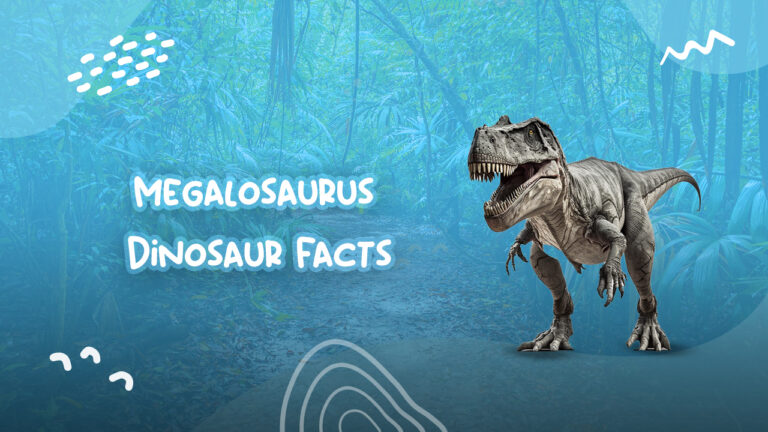Awesome Facts About Megalosaurus Dinosaur

Your curiosity about the Megalosaurus dinosaur might have led you to this page. Grab on, you are in the perfect place. In this article, we will discuss the most fascinating facts and a comprehensive overview of the Megalosaurus dinosaur, including its species and classification, diet and habitat, and paleontological discoveries.
What is a Megalosaurus Dinosaur
Megalosaurus was a gigantic carnivorous dinosaur that lived during the Middle Jurassic Period, approximately 174-164 million years ago. This fascinating creature continues to capture the attention of paleontologists, who are eager to uncover its mysteries.
Megalosaurus Dinosaur Paleontological Discoveries
The discovery of Megalosaurus by William Buckland in 1824 was a major breakthrough in paleontology. His work was groundbreaking for its time and helped to establish the science of paleontology. Buckland’s descriptions of Megalosaurus were based on fragmentary remains found in Oxfordshire, England.
He included detailed observations of the animal’s size, shape, and structure. Buckland’s discovery of the Megalosaurus and his detailed analysis of its remains was a major milestone in the field of paleontology and helped to revolutionize the way we study dinosaurs and other ancient life forms.
Megalosaurus Dinosaur Fossils
Megalosaurus, one of the earliest dinosaurs discovered, is known from fossils in England, France, and Portugal, found in diverse rock formations such as limestone and shale. The most complete fossil, unearthed in Oxfordshire, England, in 1824, has cemented its status as a prominent British fossil species.
Commonly found in formations like the Oxford and Kimmeridge Clays and the Purbeck Limestone, Megalosaurus fossils have been instrumental in reconstructing its anatomy, behavior, and the environment it inhabited, enriching our understanding of this historic dinosaur.
Megalosaurus Dinosaur Species and Classification
Megalosaurus, a well-studied theropod dinosaur genus, is divided into two subgenera: Megalosaurus, primarily known from England’s Oxford Clay, and Eustreptospondylus from Portugal’s Lourinhã Formation.
It encompasses nine species, distinguished by morphological differences, including the common Megalosaurus bucklandi, M. ambiguus, and M. pombali, plus others identified from partial remains like M. dunkeri and M. jonesii. This diversity highlights Megalosaurus’s significant classification and study within theropod dinosaurs.
Megalosaurus Dinosaur Size
Megalosaurus was a large carnivorous, bipedal dinosaur meaning it walked on two legs. Its imposing stature, with estimates suggesting it reached lengths of up to 9 meters, underscores its dominance as a predator in its prehistoric ecosystem.
Megalosaurus Dinosaur Height
Megalosaurus Dinosaur is a huge dinosaur measuring up to 9 meters (30 feet) in length, and its height at the hips could reach approximately 3 meters (10 feet), allowing it to tower over many of the contemporary species it lived alongside.
Megalosaurus Dinosaur Weight
Megalosaurus Dinosaur is incredibly heavy, weighing up to 1.5 tons, a testament to its robust build and muscular physique that enabled it to be one of the apex predators of its time.
Megalosaurus Dinosaur Skeleton
Megalosaurus had a typical theropod skeleton, with a long neck, a large head, and a long tail. Its skull was large and robust, with a short snout and large, sharp teeth. Its arms were short and its legs were long and powerful.
Megalosaurus Dinosaur Skull
The Megalosaurus dinosaur skull is an incredibly fascinating and important fossil. It had a long, low skull with large, sharp teeth. It measures about two feet long and is composed of several bones, including the maxilla, premaxilla, and dentary. The skull is also covered in a thick layer of bone, which is believed to have been used to protect the dinosaur’s brain from injury.
The Megalosaurus skull is an important fossil because it provides us with a great deal of information about the anatomy and behavior of this dinosaur. For example, the skull indicates that the Megalosaurus had a large, powerful jaw and sharp teeth, which suggests that it was a carnivore. Additionally, the skull indicates that the Megalosaurus had a relatively large brain, which suggests that it was an intelligent animal.
Megalosaurus Dinosaur Diet
Megalosaurus was a carnivore, meaning it ate other animals. It likely preyed on large animals such as other dinosaurs, as well as smaller animals like lizards and mammals. It may have also scavenged for food, eating the remains of dead animals.
This information suggests that the primary habitat of Megalosaurus was likely a relatively open area where it could hunt for its prey. Furthermore, due to its large size, Megalosaurus would have been able to roam over a wide geographic area in search of food, meaning that it likely had a scattered distribution.
Megalosaurus Dinosaur Habitat
Megalosaurus lived in a variety of habitats, including woodlands, swamps, and rivers. It was likely an opportunistic predator, preying on smaller animals such as lizards, mammals, and other dinosaurs.
Fictional Megalosaurus Dinosaur
Dinosaur King Megalosaurus Card
The Dinosaur King Megalosaurus card is coveted and potent in the Dinosaur King trading card game, renowned for its detailed artwork depicting the dinosaur’s strength. With an attack power of 2000 and the unique “Fossilize” ability to transform an opponent’s dinosaur into a fossil, it stands as one of the game’s strongest cards.
Its “Fossilize All” ability further enhances its strategic value, allowing it to fossilize all opponent’s dinosaurs and potentially dominate battles. Its rarity adds to its appeal among collectors, making it a highly prized item in the game.
Megalosaurus Dinosaur Jurassic World
Megalosaurus is featured prominently in the Jurassic World franchise. In the first movie, a hybrid dinosaur called the Indominus Rex is created by combining the DNA of several different dinosaurs, including Megalosaurus.
In the second movie, Jurassic World: Fallen Kingdom, a pack of Megalosaurus is seen attacking a group of humans. The Megalosaurus are also featured in the Jurassic World: Evolution video game, where they can be bred and trained to fight other dinosaurs.
Megalosaurus is an iconic dinosaur that has been featured in many books, movies, and video games. Its large size and fierce predatory nature make it a popular choice for dinosaur fans. It is also an important part of the Jurassic World franchise, and its presence in the movies and video games has helped to popularize the dinosaur even further.
Closing Thoughts
In conclusion, due to its large size and predatory lifestyle, Megalosaurus is one of our most iconic dinosaur species. It first appeared in the late Jurassic period, up to 160 million years ago, and is believed to have lived in forest and woodland areas around Europe.
Its name translates to “big reptile” due to its large size and is one of the most well-known species from the Jurassic period. Megalosaurus helps contribute greatly to our knowledge of dinosaurs as a whole and helps us understand more about the world of the Jurassic period.
More dinosaur facts at Dinosaurzus!

Top posts
related articles
Discover The Top 10 Longest Dinosaur Names
Dinosaurs, the ancient giants that once roamed the Earth, continue to capture our imagination. While
Discover the Amazing Dinosaur with 500 Teeth
Dinosaurs have always fascinated us with their colossal size, unique features, and intriguing mysteries. One
Acheroraptor – Tiny But Fierce Dinosaur
The dinosaur world is undoubtedly fascinating, and the relative discovery of the Acheroraptor is no
Amazing Cryolophosaurus- An Epic Tale
Cryolophosaurus, also known as the ‘Antarctic King’, was a fierce and fascinating dinosaur that existed
Discover Torosaurus And Its Mysterious Identity
Dinosaurs don’t exist anymore, but their fossils still fascinate us. Paleontologists scour the earth to
Corythosaurus–Exploring Its Wondrous World
The world of dinosaurs never stops fantastic us. From the huge T-rex to the tiny


